
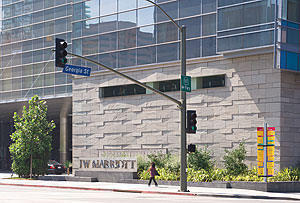
After more than a decade of planning, L.A. LIVE - a 4 million-square-foot, pedestrian-oriented entertainment and retail district in downtown Los Angeles, CA that sits adjacent to the Staples Center - has become a reality. And at the heart of the six-block development is a striking 54-story tower housing the Ritz-Carlton Hotel and Residences and JW Marriott, which features an exterior skin of variegated glass rooted by a stone base. The Pearl Grey quartzitic sandstone from India extends to the interior lobby walls, making for a smooth transition between the indoor and outdoor design.
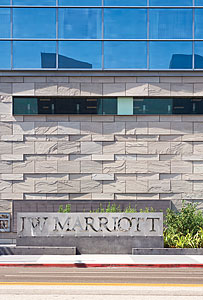
Designed by Gensler of Los Angeles, the tower features stone that was supplied by Southland Stone USA Inc. of North Hollywood, CA, and fabricated and engineered by SMG Stone of Sun Valley.
“The project is a vertical tower,” said Kapil Malik, AIA, Design Director at Gensler. “We shaped the building as a prism. The tower gets thinner as it rises to the sky. It’s the only tower in LA that can be seen from 360 degrees.
“Each hotel has its own identity and its own drop-off,” Malik continued. “The glass skin is designed as variegated because the program moved horizontally and vertically - each has its own module. JW Marriott is 30 feet and the Ritz is 35 feet.”
Malik went on to explain that four different types of glass were utilized to create the variegation. “It was designed to respond to the program behind it,” he said. “The tower comes to the ground on the base with a pass-through lobby. We chose Indian sandstone for the base.”
According to the architect, sandstone was selected because the design objective was to make it feel like the building rose out of the ground. “The stone was designed as a basketweave - every layer moves in and out,” he said. “As the sun hits the glass, there is a nice pattern on the stone when it hits. The idea was to create texture and pattern with shade and shadow - to give depth to the stone.”
One of the primary reasons the stone was carried inside and outside the tower was because of the expansive size of the building, explained Malik. “We split the lobby as though we were splitting a solid rock,” said the architect. “We brought stone inside the lobby to have continuity.”
The walls of the main lobby are dressed in Pearl Grey sandstone, while the floor consists of three varieties of Chinese granite in shades of white, black and gray. Granite pavers were also employed for the ground floor plaza.
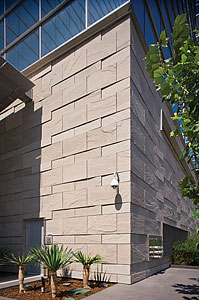
Visiting the quarry
Malik explained that he traveled to India along with Ravi Johar from Southland Stone and Solomon Aryeh from SMG Stone for the stone selection process. The Pearl Grey sandstone had been chosen for its coloring, strength and texture.
“We were looking for a beige/gray stone that was very dense,” said the architect. “It had a textural quality to it. We all went down to India and looked at the quarry. We were looking for the color. We selected a color range, and we were looking for all the same variegated stone. We also made sure [the stone pieces] were fabricated to the specification of the design.”
The Pearl Grey sandstone panels were specified in two sizes - 1- x 3.6- and 2- x 3.6-foot slabs. Each had a thickness of 1 ¼ inches.
“We did a mock-up at the quarry in India,” said Malik. “It was 20 x 30 feet. We looked at the range, selected the range and pulled out stone that we didn’t want. Half of the mock-up was left in India and the other half brought to [the jobsite].”
The architect went on to explain that a second mock-up was constructed at the site. “We did it with SMG,” he said. “We wanted to make sure that the stone selected was the same stone.”
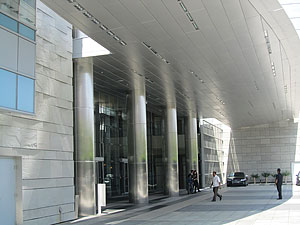
Working in the field
Senior Project Architect Warwick Wicksman, AIA, of Gensler was heavily involved in the technical aspects of the project. “It was our job to determine how to detail the pattern [of the stone] so it could be built correctly in the field,” he said. “We originally specified a panelized stone system that would be hung on the building, but it proved to be too expensive. We worked with the subcontractor, and decided to hang the stone in a more traditional method, and achieved the same pattern.”
Wicksman explained that mounting clips were installed behind the individual sandstone pieces, at pre-determined varying depths. “We came up with the details how to do it,” he said. “It looks complicated, but it really is a simple system when you think about it. They are consistent bands of stone, the larger one angling in and out, and the smaller one in a sawtooth pattern. The bands get stacked and offset to create the basketweave pattern. Once you break down its components, it becomes a simple modular system.”
According to the architect, SMG Stone subcontracted the installation to AGI Marble. “We worked with both groups - engineering and installation - working as one team,” he said. “SMG developed the final engineering for the system. AGI executed the construction in the field. We worked together as one team.”
Once they decided to move away from a panelized system, developing details for the mechanical anchoring system was a relatively short process, said Wicksman. “It didn’t take long to come up with the concept,” he said. “It took about a month of going back and forth with the team to work out the final details. Then we made some minor adjustments in the field.”

Wicksman explained that several mock-ups were done during the installation process. “The mock-ups were critical to make sure that the pattern was consistent, and to make sure that the stones were in the color range that was selected,” said the architect. “One of the biggest issues we faced was making sure the waterproofing system was correct. We used a rain screen. It’s an open-jointed stone facade, and all of the waterproofing intersected with the other building elements to maintain a consistent weather barrier. We had D7, a waterproofing consultant, on board for helping us develop the details, and for full-time inspection.
“There were also a lot of field conditions we had to address with the team,” Wicksman went on to say. “Questions came up in cases where the stone would meet the curtainwall or a door or window frame. We had to coordinate how to terminate the pattern. We were adjusting joint widths in the field to make the pattern read properly.”
In the end, Wicksman was satisfied with the result. “It came out beautifully, and we were able to carry the same stone system through to the interior of the hotel lobby,” he said.

Overseeing the installation process
According to Solomon Aryeh, owner of SMG Stone Co., Inc., the sandstone pieces were mechanically attached with stainless steel anchors and had an open joint. “We designed all attachments and assisted the architect in achieving the goal,” said Aryeh. “Each piece is independently attached to the building and carries its own weight.”
Once the team at SMG Stone received the stone pieces from India, they conducted an extensive blending process to make sure the overall appearance was aesthetically pleasing. “A lot of effort went in to mixing [the stone pieces] to make them appear uniform,” said Aryeh.
In addition to supervising AGI on the installation of the sandstone on the tower’s base and interior lobby walls, SMG Stone also was responsible for fabricating and engineering all the bar tops and grand staircases in the tower’s main lobby. The company also fabricated and engineered stone and tile in the hotel and residential lobbies of the Ritz-Carlton Hotel & Residences as well as in all of the interior units of the Ritz-Carlton residences and hotel rooms in the JW Marriott.
“We were involved in the project for about two-and-a-half years - starting with the shop drawings,” said Aryeh. “Our tasks were everything from floating concrete substrate to waterproofing and soundproofing to supervising the stone and tile installation. There was about a half-million square feet of stone, tile, crystallized glass and marble.
“The biggest challenge was, of course, schedule,” Aryeh went on to explain. “AGI had to turnaround and complete one floor in five days, which was approximately 50 rooms. There were a total of 872 rooms.”
On average, 140 workers were on the jobsite, although at the busiest times, there were as many as 200. “AGI was working from the parking level all the way through the 49th floor,” said Aryeh. “Another big challenge was to manage people on every floor in the building.”
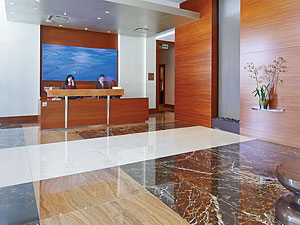
Creating a landmark
The Ritz-Carlton Hotel and Residences and JW Marriott tower at L.A. LIVE is the first skyscraper project built in downtown Los Angeles in almost 20 years. Connected to the tower by a skywalk is an 80,000-square-foot conference center that includes a 26,000-square-foot ballroom.
Planning for L.A. LIVE began in 1999. The tower and convention center comprise 4 million square feet of the development. The building, which is designed to achieve LEED Silver certification, features two outdoor decks with pools, bars and events facilities. The fourth floor outdoor space, with a 1,000-person capacity and views to neighboring Nokia Plaza, is for guests of the JW Marriott hotel. The 26th floor deck offers exclusive views of the downtown skyline and the Nokia Plaza below.
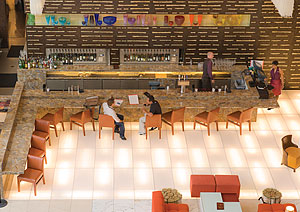
The Ritz-Carlton Hotel and Residences and JW Marriott tower
L.A. LIVE: Los Angeles, CA
Architect: Gensler, Santa Monica, CA
Stone Supplier: Southland Stone USA, Inc., North Hollywood, CA
Stone Fabricator/Engineer: SMG Stone, Sun Valley, CA (bar tops and grand staircases in the tower’s main lobby, the hotel and residential lobbies of the Ritz-Carlton Hotel & Residences, all of the interior units of the Ritz-Carlton residences and hotel rooms in the JW Marriott)
Stone Installer: AGI Marble, Sun Valley, CA
